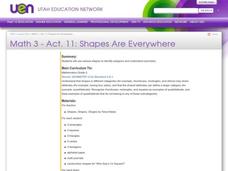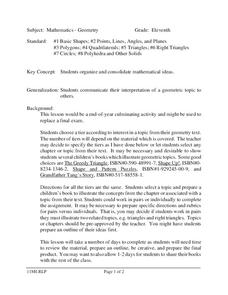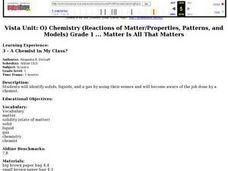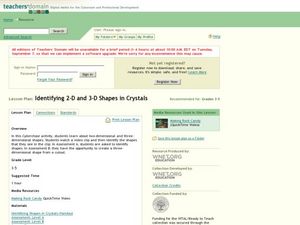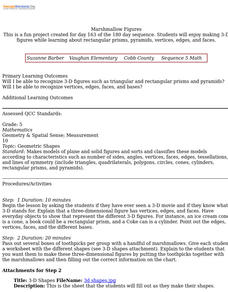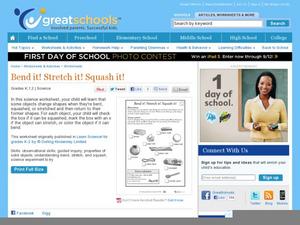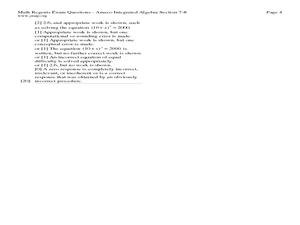Curated OER
Using Geometric Shapes in Architecture
Third graders identify two and three dimensional shapes used in architectural designs by viewing images on the Internet. For this geometry lesson, 3rd graders create their own building designs and identify the geometric shapes that...
Curated OER
Exploration with Geometric Solids
Students reinforce geometric concepts by playing "Guess My Solid." Through a process of elimination, they determine the shapes of mystery solids. Finally, students use various materials to construct their own geometric figures.
Curated OER
Shapes Are Everywhere
Third graders use various shapes to identify polygons and understand symmetry. They explore pattern blocks noticing their similarities and differences, then share with other team members. They draw 3 polygons in their journals and...
Curated OER
Basic Shapes
Students create books about shapes. In this shape lesson, students select a topic such as points, lines, angles, planes, polygons, quadrilaterals, triangles, circles, and polyhedra. In groups, they create an illustrated...
Curated OER
Matters of Milk and Marshmallows
Students observe a teacher demonstration o classifying matter by its physical properties of shape and size. After discussing the definition of matter, students describe the state of matter. They sing a song to the tune of "Bingo." In...
Curated OER
A Chemist in My Class?
First graders in kindergarten science class discuss matter. They make predictions and then identify mystery items in brown paper bags as either solid, liquid, or gas by using their senses. They discuss that a chemist is a scientist that...
Curated OER
Circles 1, 2, 3, 4
Here is a way to help your charges identify circles and spheres. In this shapes geometry and technology lesson plan, students identify and draw circles and explain the related attributes. They recognize circles and spheres while...
Curated OER
Spacemobiles
Aspiring astronauts construct a space vehicle using cylinders, cones, spheres, and rectangular prisms. This is an engaging method of learning about three-dimensional shapes. Note that the word cylinder is constantly misspelled in the...
Curated OER
Classifying Solids
In this geometry worksheet, students write the name of the shape, and identify the number of vertices, edges, and faces for 6 e-dimensional shapes. Students draw 3 shapes, and classify groups of pictures.
Curated OER
Volumes of Solids
In this volume worksheet, students observe diagrams and extrapolate the correct items to plug into a formula for volume. They find the volume of triangular prisms, cylinders, cones, rectangular prisms, and rectangular pyramids. Four of...
Curated OER
Geometric City
Students brainstorm names of plane and solid geometric figures. Afterward, they explore the skyline of large cities and note their agricultural shapes. Using construction paper, students build 3-D geometric structures to create a skyline...
K12 Reader
3-D: It’s Not Just for Movies
This two-part reading comprehension exercise asks kids to read a short passage about cubes, rectangular prisms, spheres and pyramids, and then to respond to a series of questions about the article.
Curated OER
Truncated Dodecahedron
In this math worksheet, students build a truncated dodecahedron. This is a solid shape with 12 regular decagonal faces and 20 equilateral triangular faces. Students build this shape to assist in developing their cognitive and geometric...
Curated OER
Space Shapes
Young scholars read "Captain Invincible and the Space Shapes" by Stuart Murphy and view a PowerPoint presentation on shapes. They identify shapes presented in the book and then identify shapes found in their classroom.
Curated OER
Identifying 2-D and 3-D Shapes in Crystals
Students view a video on making rock candy and identify the shapes they see while watching. For this 2 and 3 dimensional shape lesson, students recognize shapes and complete worksheets to identify them. Students build a cube....
Curated OER
Analyzing 3-D Shapes and 2-D Representations
Students can analyze 3-D objects better with actual physical models and by also drawing 2-D representations of them.
Curated OER
3rd Grade Math
In this math review worksheet, 3rd graders complete multiple choice questions about shapes, money, weight, and more. Students complete 20 questions.
Curated OER
Marshmallow Figures
Students enjoy making 3-D figures while learning about rectangular prisms, pyramids, vertices, edges, and faces. After a lecture/demo, students use marshmallows, toothpicks and a worksheet imbedded in this lesson to create 3 dimensional...
Curated OER
Bend It! Stretch It! Squash It!
Some items keep their shape no matter what happens! Have your kindergarten class choose which items would stay the same if they were bent, stretched, or squashed. The last activity prompts kids to see what happens when they stretch a...
Curated OER
Twenty Volume Of Solids Problems
In this volume worksheet, students solve twenty volume of various solids problems. The solids examined include: cylinders, cubes, rectangular prism, including how the volumes of these figures change with increased in length. ...
Curated OER
Visualize 3-D Objects and Make Nets of Common Solids
In this 3-D objects and common solids worksheet, students cut out and count the number of faces on several different types of boxes and make a cuboid from straws or a card. Students fill out 4 different categories involving 5 different...
Pennsylvania Department of Education
A Geometric Scavenger Hunt
Fifth graders connect their knowledge of polygons and polyhedrons. For this geometric shapes lesson, 5th graders identify and classify two- and three-dimensional objects. Students construct a polyhedron out of polygons and describe their...
Curated OER
How many edges do I need to cut in order to open a cube?
Young scholars problem solve to open a cube to create different shapes. In this problem solving lesson plan, students are given a cube and the shapes to open it up to, and they have to cut the cube open to make certain shapes. This gives...
Curated OER
Introducing Powers and Models
Young scholars construct two dimensional models to illustrate squared numbers. In this geometry lesson, students use graph paper and an x/y axis to build squares exponentially. Young scholars identify powers and relationships between...


